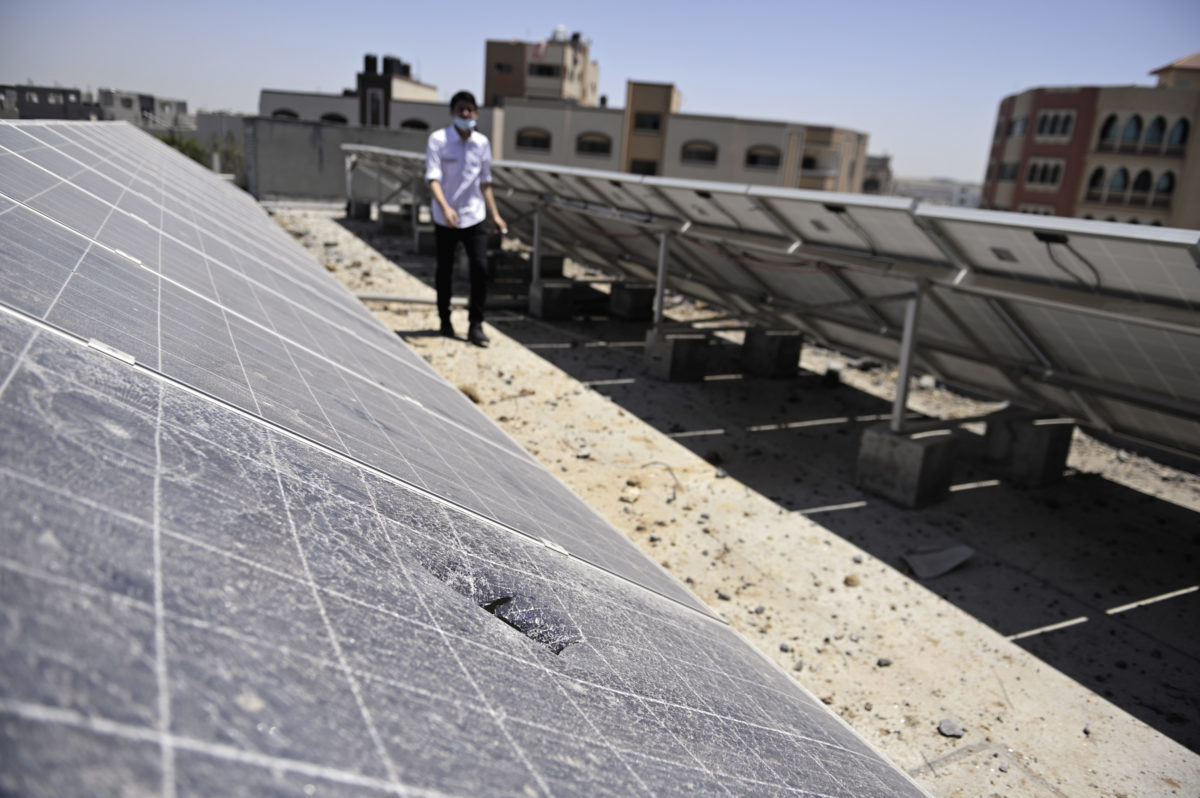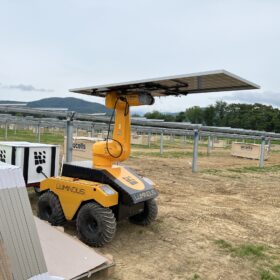From pv magazine 07/2021
A chronic electricity deficit within Gaza continues to have a negative impact on health, water and sanitation services. Local communities, as well as international organisations, are reaching for solar power in the hope of building a more resilient future, but the challenges are immense: closed borders, damage to existing solar, limited supplies, and limited space. Nevertheless, the need is undeniable.
“Electricity is critical to all our lives and we don’t realise it until we don’t have it. It is particularly the case in Gaza, as households get as low as four to five hours of electricity per day,” said Chitose Noguchi, who currently works for the United Nations Development Programme (UNDP) as the deputy special representative to the Palestinian people and the head of its office in Gaza. She describes the situation as representing an energy crisis.
“Basic services related to schools, hospitals, and water desalination and treatment all rely on electricity. Not having a stable supply makes it extremely difficult for people in Gaza to have a normal life and get access to the very basic needs,” added Noguchi.
Solar in Gaza
The energy situation in the small coastal enclave, populated mostly by Palestinian refugees, drastically deteriorated after the recent escalation between the ruling Hamas organisation and the Israeli military. The deficit between energy supply and demand has grown further, reaching a 75% shortfall and prompting Gaza Electricity Distribution Corp. to deliver only four hours of electricity at a time, followed by 16 hours without power.
The company said that the ban on the entry of fuel triggered a decline in electricity produced by the only power plant in Gaza. This power plant has a current working capacity of 45 MW, down from its original capacity of 140 MW, as it has been bombed in the recent rounds of violence. Electricity shortages have been common for Gaza in the last decade, although the situation had improved slightly over the past few years.
In light of the dysfunctional nature of the grid, diesel generators have become the primary source of electricity, leading to greater dependency on limited fuel supplies. However, the aggregated supply from all sources remains far from meeting Gaza’s electricity needs.
In parallel, solar energy is transforming Gaza’s energy system. The simplicity and modality of disturbed-generation PV systems allow for them to become the favourable solution to overcome power outages. Additionally, the region has excellent solar resources, with 320 days of sunshine per year on average, making solar projects a worthy investment.
As early as 2013, hospitals in Gaza started to employ solar PV systems to secure their electricity supply. Solar systems are often coupled with hybrid battery storage or diesel generators in a hybrid way to provide electricity during the night. Systems connected to the grid under a net-metering scheme are in principle allowed by the Palestinian authorities. However, further regulation is needed to ensure technical compatibility with utility networks.
In terms of numbers, around 10 MW of solar PV systems are installed by aid agencies and another 10 MW are in the pipeline. A 7 MW project is also under implementation to install 21,000 solar panels on the rooftops of factories and warehouses in Gaza’s industrial zone. Although many factors encourage the development of solar PV projects in Gaza, political instability and the limited availability of uninhabited areas can hinder large-scale solar PV developments.
Educational struggles
Solar systems have thus far focused on delivering power for the critical services of health, education, and sanitation. Here the UNDP is engaged, explained Noguchi. “In Gaza, we have been focusing on providing support, whether it’s standalone solar projects or whether it is incorporated into existing facilities,” she said. “We have provided several solar systems to schools, health facilities, and wastewater treatment plants. In total, UNDP has installed 2.5 MW of solar projects, investing around $6 million.”
In particular, the education system in Gaza is suffering from the electricity shortages. As schools often have to operate multiple shifts to accommodate all students, many classes are being held in the early morning or in the evening hours when lighting is needed. Electricity is also needed to operate computers and labs.
Unfortunately, some of the solar systems that UNDP has installed on schools have sustained damages in the recent Israeli attacks on Gaza. For instance, in one newly installed solar system in a private school that serves 950 students, 130 modules from a total of 170 were damaged. Six other systems installed on governmental schools went offline and require repair.
The borders of Gaza remain closed after the recent escalation, but Noguchi hopes that soon it will again be possible to bring solar equipment into the region. The UNDP alone has many active solar projects in Gaza, as well as in the West Bank of the occupied Palestinian territories, cooperating with various donors and partners. Officials at the organisation highlight the need for more donor support and are seeking cooperation opportunities with suppliers and manufacturers of solar equipment.
Water issues
The water situation is no better. Scarce groundwater and supplies from Israel are the only sources of fresh water. Often households have to go for days without running water. Wastewater ends up in the ground or the sea, as the treatment facilities are not sufficient. In recent weeks, untreated water was pumped into the sea around Gaza during the escalation, creating an environmental crisis.
It is hoped that a recently commissioned treatment plant will improve the situation. Funded by the German government, the Gaza Central Treatment Plant was put into operation on April 28. The plant will allow the wastewater for around 1 million inhabitants to be reliably treated. Remarkably, the plant is energy self-sufficient, with its own solar system and biogas generator. The plant will probably also supply neighbouring communities with electricity thanks to excess generation. The UNDP is leading similar efforts to install solar panels at Khan Younis Waste Water Treatment Plant with the aim of reducing operational costs by 50%.
Health benefits
Solar electrification of the health system in Gaza has been found to have great potential, as per a technical assessment conducted in 2019 by the Palestinian Ministry of Health, in cooperation with international organisations. Hospitals and health facilities can achieve annual savings in electricity costs of $2.6 million by introducing solar PV systems, combined with energy efficiency measures. The study notes that the daily energy demand projected to be met by the proposed solar systems will vary depending on the availability of physical space for array deployment. Such projects will make hospitals more resilient against power outages. This is currently critical given the increasing demand for cooling amid Covid-19 vaccination efforts.
Farmers are also benefiting from solar applications to protect agricultural production and improve their livelihoods. PV technology is an excellent alternative to operate irrigation wells and pumping systems. In one project supported by the UN Food and Agriculture Organisation, 16 irrigation wells and 51 water harvesting ponds were equipped with solar-powered pumping systems. The project succeeded in increasing the quantity of water extracted and thus the agricultural output, by reducing the operating costs for farmers by 70%.
Female empowerment
Beyond the direct benefit of solar energy in providing affordable and clean electricity, it is also creating new growth and employment opportunities in Gaza. With the 70% youth unemployment rate and the nearly 14-year blockade, Gaza’s economy is in desperate need of revival.
UNRWA, the Palestinian refugee agency, is offering vocational training on solar that includes the installation and maintenance of PV systems. Trainees get their first hands-on experience in a solar energy laboratory and workshop equipped with sample equipment and measurement tools. The graduates are then granted apprenticeship employment opportunities at local companies.
This initiative, funded by the German development agency GIZ, aims to boost community awareness and adaptability, while also promoting sustainable energy sources. Women are remarkably participating in this empowerment opportunity, breaking barriers in a field dominated globally by men.
UNRWA reports one such success story, Ghada Zaki, who completed one of the training courses. The 20-year-old woman described her first days in the training program, before she became one of the first female technicians to install, operate, and repair solar photovoltaic systems for a local company.
“At first, our colleagues who were men were astonished that there were women in the program. They would question our ability to hold the drill and weld steel beams, but we paid no mind,” Zaki said. “The women supported each other until the camaraderie became infectious and our male colleagues evolved and began to support us as well.”
Author: Amjad Khashmann
This content is protected by copyright and may not be reused. If you want to cooperate with us and would like to reuse some of our content, please contact: editors@pv-magazine.com.








9 comments
By submitting this form you agree to pv magazine using your data for the purposes of publishing your comment.
Your personal data will only be disclosed or otherwise transmitted to third parties for the purposes of spam filtering or if this is necessary for technical maintenance of the website. Any other transfer to third parties will not take place unless this is justified on the basis of applicable data protection regulations or if pv magazine is legally obliged to do so.
You may revoke this consent at any time with effect for the future, in which case your personal data will be deleted immediately. Otherwise, your data will be deleted if pv magazine has processed your request or the purpose of data storage is fulfilled.
Further information on data privacy can be found in our Data Protection Policy.